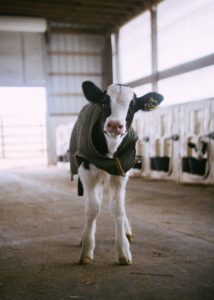Today, USDA announced a suite of new actions delivering on key commitments from President Biden’s Executive Order on Promoting Competition in the American Economy, including issuing a new Packers & Stockyards Act rulemaking, making available $200 Million to expand competition in meat processing, and investing $25 million in workforce training
WASHINGTON, May 26, 2022 – U.S. Department of Agriculture (USDA) Secretary Tom Vilsack today announced more support, resources, and new rules that will strengthen the American food supply chain, promote fair and competitive agricultural markets, prevent abuse of farmers by poultry processors and make prices fairer for farmers and American consumers. These actions build on President Biden’s
historic whole-of-government effortto promote competition in the American economy and fulfill key pillars of the
Meat and Poultry Supply Chain Action Plan launched in January by President Biden, Secretary Vilsack, and Attorney General Garland. These actions combat
market dominance by a small number of major meat and poultry processors in key markets, where excessive concentration and control has led to lower prices paid to producers and higher prices paid by consumers.
“For too long, farmers and ranchers have seen the value and the opportunities they work so hard to create move away from the rural communities where they live and operate,” Vilsack said. “Under the leadership of President Biden and Vice President Harris, USDA is committed to making investments that promote competition—helping support economic systems where the wealth created in rural areas stays in rural areas—and strengthening rules and enforcement against anticompetitive practices. The funding and new rule we’re announcing today ultimately will help us give farmers and ranchers a fair shake, strengthen supply chains, and make food prices fairer.”
Fighting for Fairness for Poultry Farmers
USDA today announced a proposed rule under the Packers and Stockyards Act to protect poultry growers from abuse. Today’s action is the first of three rulemakings that USDA will issue under the Packers and Stockyards Act under the
President’s Executive Order on Promoting Competition in the American Economy in order to stop unfair, deceptive, discriminatory, and anticompetitive practices in the meat and poultry industry.
Currently, poultry processors exert control over much of the process of raising chickens through take-it-or-leave-it contracts with growers. Under these contracts, processors provide inputs like chickens and feed to poultry growers. Poultry growers, who often take on debt to build poultry growhouses, have limited visibility into the real range of outcomes and risks they face under these contracts. Moreover, once in the contracts, the processors then determine the payments that poultry growers receive for their services by weighing the chickens and ranking farmers based on how much the chickens grew. Pay is generally determined based on how a farmer compares to other farmers, but farmers currently have little insight into this comparison. For far too long, growers have complained that the “tournament” system is ripe for abuse.
The new rulemaking will require poultry processors to provide key information to poultry growers at several critical steps—increasing transparency and accountability in the poultry growing system. For example, processors would be required to disclose details of the inputs they provided to each farmer and information about the input differences among farmers being ranked. Furthermore, disclosures would cover the level of control and discretion exercised by the poultry processor and what financial returns the farmer can expect from the relationship based on the range of real experiences of other growers. Contracts would also be required to contain guaranteed annual flock placements and density. Poultry processor CEOs would be required to sign off on the compliance process for disclosure accuracy.
Simultaneously with issuing the proposed transparency rule, USDA is opening an inquiry into whether some practices of processors in the tournament system are so unfair that they should be banned or otherwise regulated. USDA seeks input from stakeholders to determine whether the current tournament-style system in poultry growing could be restricted or modernized to create a fairer, more inclusive marketplace.
Investing in Expanded Capacity
Vilsack also announced that USDA is making available $200 million under the new
Meat and Poultry Intermediary Lending Program (MPILP) to strengthen the food supply chain and create opportunities for small businesses and entrepreneurs in rural communities. These funds will provide much-needed financing to independent meat and poultry processors to start up and expand operations. By introducing competition at this key bottleneck point in the supply chain, these investments will help raise earnings for farmers and lower prices for consumers.
The MPILP will provide grants of up to $15 million to nonprofit lenders, including private nonprofits, cooperatives, public agencies and tribal entities. These intermediaries will use this funding to establish a revolving loan fund to finance a variety of activities related to meat and poultry processing. For example, businesses may use the loans to acquire land, build or expand facilities and modernize equipment.
Building a Well-Paid, Well-Trained Meat and Poultry Processing Workforce
Vilsack also announced $25 million in investments for workforce training programs for meat and poultry processing workers with American Rescue Plan Act Section 1001 funding. The targeted funding through new and existing National Institute of Food and Agriculture (NIFA) programs is designed to create and expand upon good paying jobs that can strengthen the meatpacking industry by attracting and retaining employees.
NIFA is leading two funding opportunities:
- Extension Risk Management Education and Sustainable Agriculture Research Education Programs: An investment of $5 million will be split equally between Extension Risk Management Education and Sustainable Agriculture Research Education programs. Work in these programs will support development of meat and poultry processing training and educational materials for place-based needs, particularly relevant to small- or medium-sized farmers and ranchers. Additionally, training local and/or regional meat and poultry workers presents a unique opportunity to address the demand from niche markets, like mobile processing units fulfilling market demand from fresh markets, on-site processing, farm-to-fork (restauranteurs), boutique grocers and others.
- Community/Technical College Ag Workforce Training and Expanded Learning Opportunities: This Agricultural Workforce Training (AWT) investment makes available $20 million to qualified community colleges to support meat and poultry processing workforce development programs. The AWT program helps develop a workforce ready for the field as well as industry jobs in the food and agricultural sectors. By creating new workforce training programs, or expanding, improving, or renewing existing workforce training programs at community, junior, and technical colleges/institutes, this program will expand job-based, experiential learning opportunities, acquisition of industry-accepted credentials and occupational competencies for students to enable a workforce for the 21st century.
- For more information, please visit NIFA’s Webpage and read NIFA’s agency announcement.
Charting a Comprehensive Strategy for Promoting Competition in Agricultural Markets
Today, USDA also released a new report on Promoting Competition in Agricultural Markets, as required by President Biden’s Executive Order on Promoting Competition in the American Economy. The report details USDA’s strategy for promoting competition in agricultural markets—including not only actions and initiatives to promote competition in meat and poultry markets, but also other key agricultural sectors like fertilizer and seeds. The report also discusses the negative impacts concentration in shipping has on our food supply chain and describes USDA’s efforts to work across the Administration to use all available tools to promote competition.
The report includes the announcement of two new pro-competition initiatives—initiatives that go above and beyond those required by the Executive Order. First, USDA is announcing plans to complete a top-to-bottom review of its programs to ensure they promote competition. Second, USDA announced it will update guidance to strengthen the verification requirements for the most widely used “animal-raising claims” to ensure consumers are getting what they are paying for.
Biden-Harris Administration Commitment to Supporting American Farmers and Ranchers
These steps are pursuant to President Biden’s Executive Order on Promoting Competition in the American Economy and his Executive Order on America’s Supply Chains. As Co-Chair of the Biden-Harris Administration’s Supply Chain Disruptions Task Force and as a member of the White House Competition Council, Secretary Vilsack and USDA have brought together industry, labor and federal partners to address the short-term supply chain disruptions arising from the Administration’s strong economic recovery and to address longstanding problems with the lack of competition in our economy. Today’s announcements are among many key steps that USDA is taking to build a more resilient supply chain and better food system and to increase competition in agricultural markets. This initiative will support key supply chain infrastructure investments to expand and scale existing capacity, as well as support long-term investments in new operations. See all recent actions taken to support the American food supply chain on
www.usda.gov/meat.
USDA touches the lives of all Americans each day in so many positive ways. Under the Biden-Harris Administration, USDA is transforming America’s food system with a greater focus on more resilient local and regional food production, promoting competition and fairer markets for all producers, ensuring access to safe, healthy and nutritious food in all communities, building new markets and streams of income for farmers and producers using climate-smart food and forestry practices, making historic investments in infrastructure and clean energy capabilities in rural America, and committing to equity across the Department by removing systemic barriers and building a workforce more representative of America. To learn more, visit
www.usda.gov.

 Photo by
Photo by 